GENERAL KNOWLEDGE
Kimchi ([kɪmtʃiː],[gimchi]) is a traditional Korean fermented food and a kind of cooking style; a staple in Korean cuisine served as a side dish; food that is with seasonings containing vegetables that have been pickled and fermented in brine(salt water) to improve storage.
The world’s famous Kimchi is referred to the southern type of Asian cabbage (Baechu) Kimchi which is made with red chili powder. Besides it, there are various types of kimchi characterized by the different main materials and seasonings depending on seasons and regions.
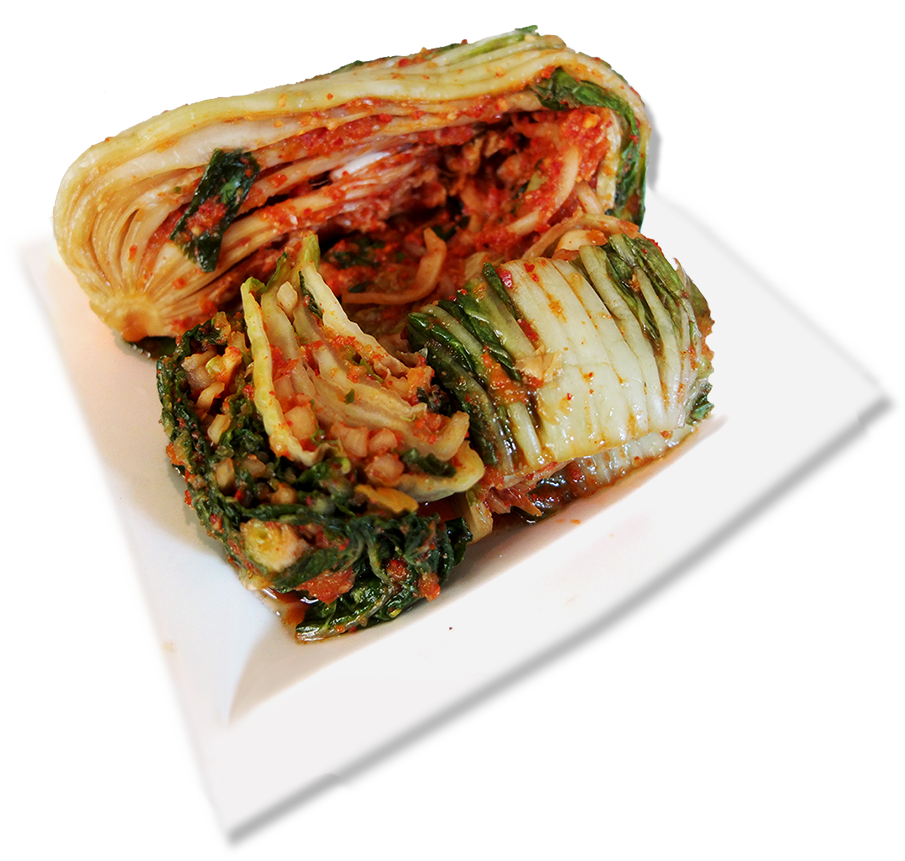

It can be served as freshly-made Kimchi, 겉절이(Geotjeori), or long-term storage food that can be eaten for several years as 묵은지(Mugeunji) storing in Kimchi refrigerator or in large earthenware fermentation vessels, 항아리(Hangari), in the ground to prevent freezing during the winter months and to keep it cool enough to slow down the fermentation process during summer months.


Korea has a long history of eating Kimchi, and even today, even one-person households have at least kimchi, so it is a dish that is very closely related to the lives of Koreans.
timchɑi (팀채; 沈菜) > dimchɑi (딤채) > jimchɑi (짐채) > jimchui (짐츼) > gimchi (김치)
Varieties of Kimchi
Variations are unlimited, as Koreans says “can make kimchi out of anything edible; a concept which extends toward infinite possibilities…” – made with different vegetables as the main ingredients; Asian cabbage, Korean white radish, young radish leaves, young radish, dried radish, cucumber, mustard leaves, spring onion, garlic chives, Bokchoi, balloon-flower root, perilla leaves, onion, etc.
Baechu Kimchi
배추김치
Asian / Chinese / Napa Cabbage

Gat Kimchi
갓김치
Mustard Leaves

Kakduki
깍두기
Asian / Korean Radish
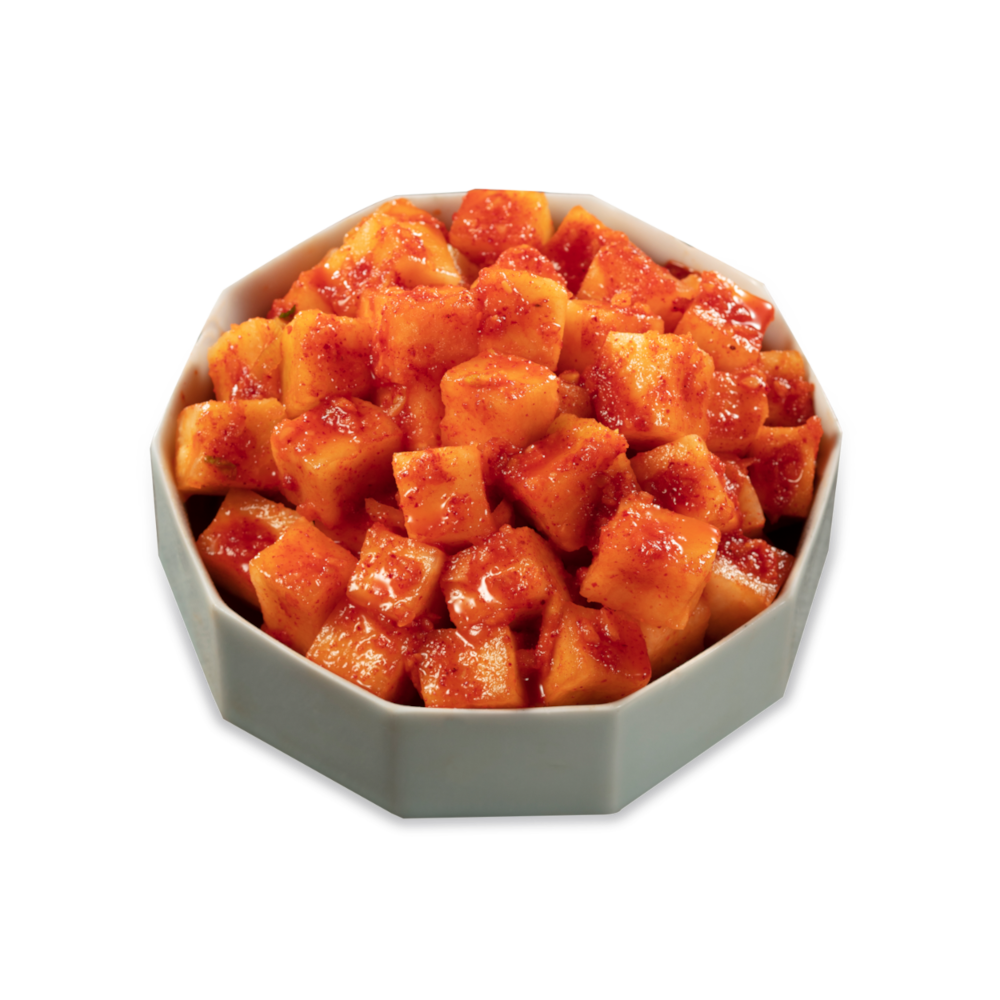
Oi Sobaki
오이소박이
Cucumber

Baek Kimchi
백김치
Asian / Chinese / Napa Cabbage

Yangbaechu Kimchi
양배추김치
White Cabbage

Chonggak Kimchi
총각김치
Ponytail Radish

Pa Kimchi
파김치
Spring Onion
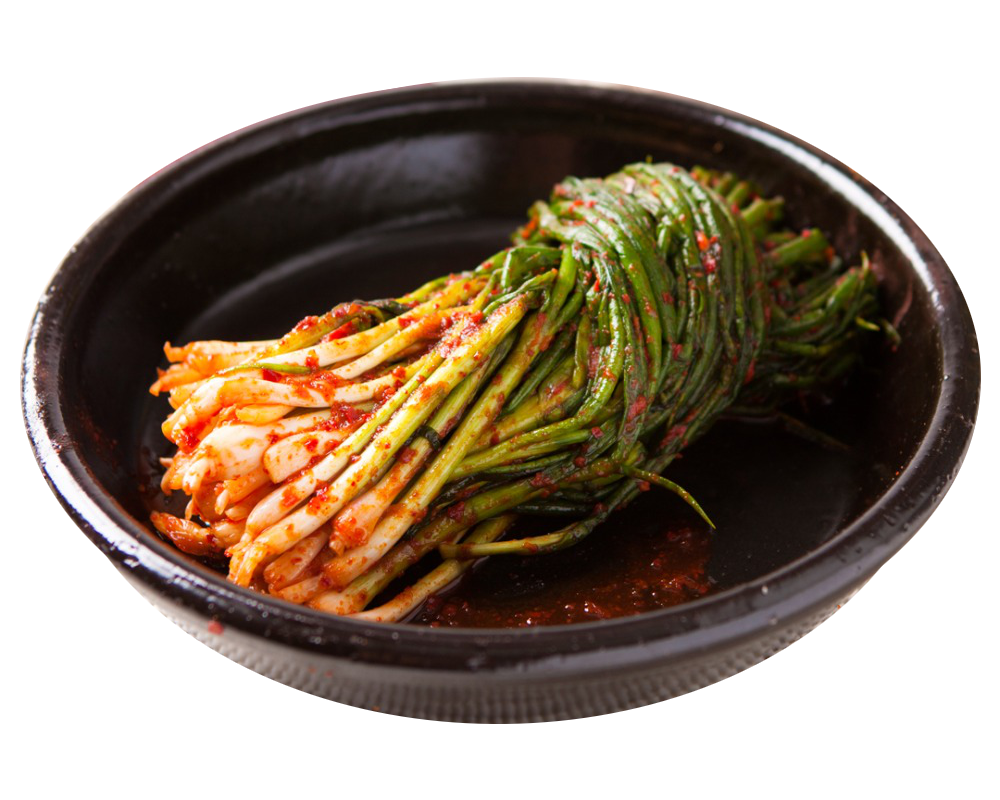
Bossam Kimchi
보쌈김치
Asian / Chinese / Napa Cabbage
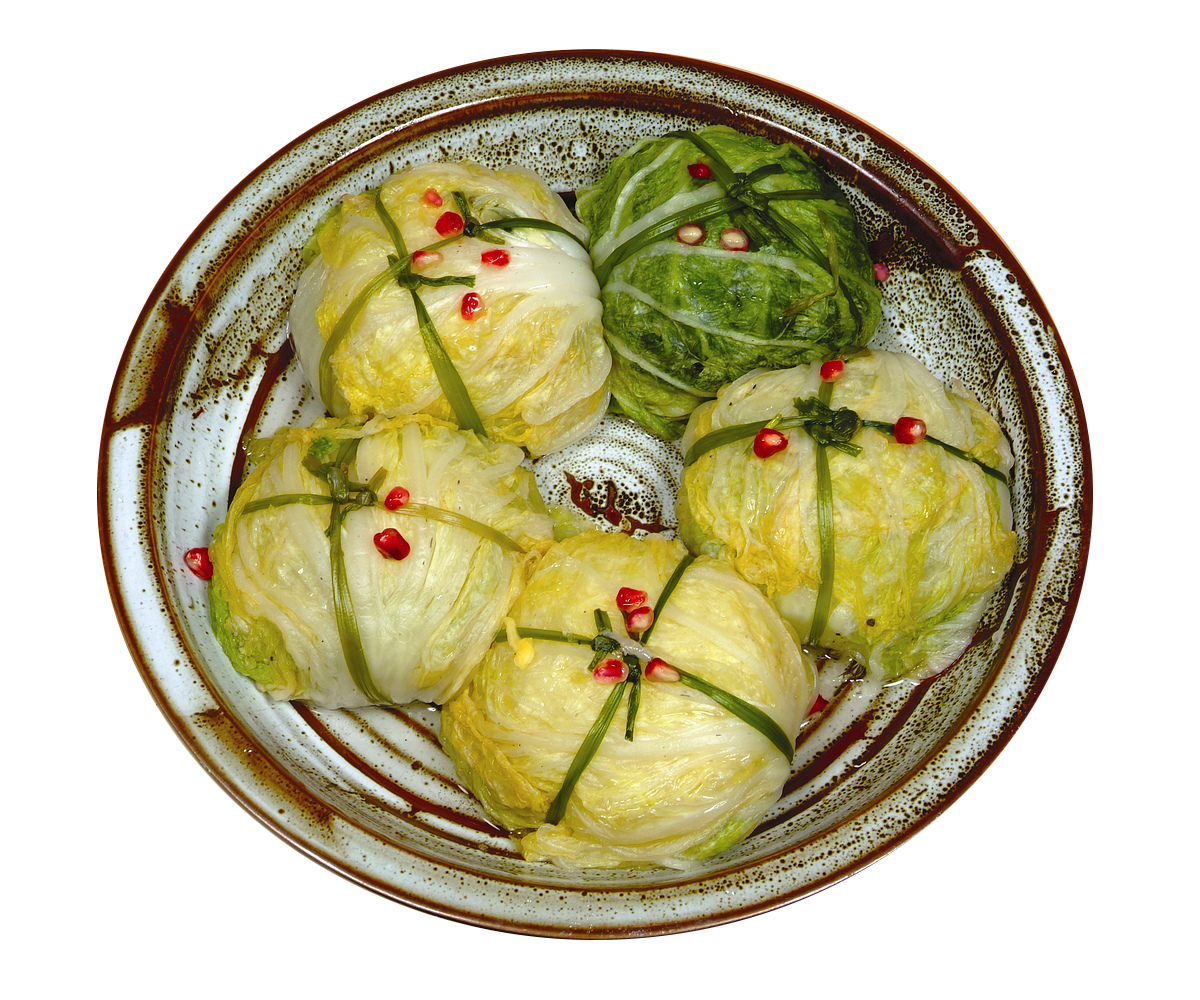

Yoelmu Kimchi
열무김치
Young Korean Radish Leaves


Dongchimi
동치미
Korean Radish in Water

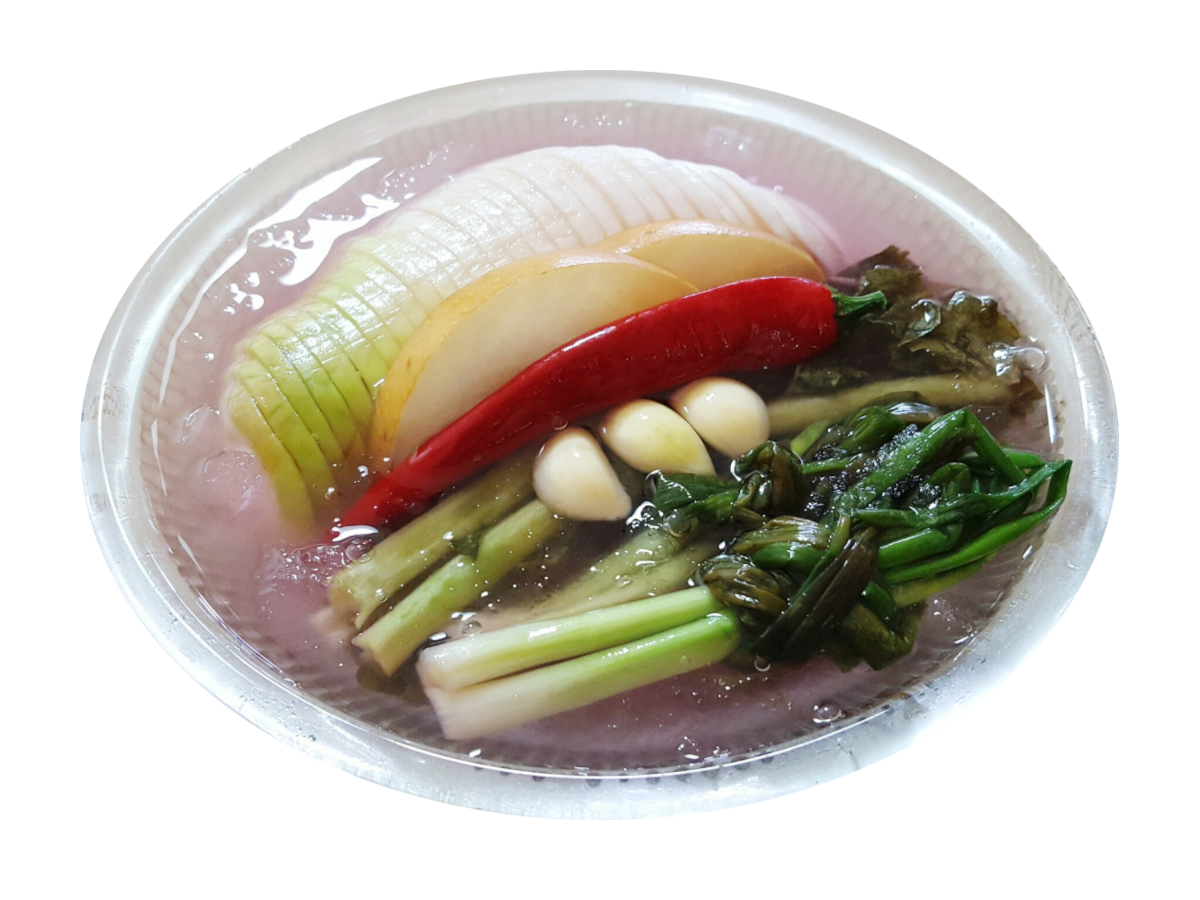
Nabak Kimchi
나박김치
Mixed Veggies in Water

Seasonal Variety
Different types of kimchi were traditionally made at different times of the year, based on when various vegetables were in season and also to take advantage of hot and cold seasons before the era of refrigeration. Although the advent of modern refrigeration — including Kimchi refrigerators specifically designed with precise controls to keep different varieties of Kimchi at optimal temperatures at various stages of fermentation — has made this seasonality unnecessary, Koreans continue to consume Kimchi according to traditional seasonal preferences.
- Spring : After a long period of consuming 김장김치(Kimjang Kimchi) during the winter, fresh potherbs and vegetables were used to make kimchi. These kinds of kimchi were not fermented or even stored for long periods of time but were consumed fresh.
- Summer : 열무김치(Yeolmu Kimchi) made with radish leaves and 오이소박이(Oi Sobaki) made with cucumbers are summer Kimchi. Brined fish or shellfish can be added, and freshly ground dried chili peppers are often used.
- Autumn : 배추김치(Baechu Kimchi) is prepared by inserting blended stuffing materials, called 김치소(Kimchiso) or 속(Sok) meaning literally inside, between layers of salted leaves of uncut, whole Asian cabbage. The ingredients of 김치소(Kimchiso) can vary, depending on the regions and weather conditions. Generally, Baechu Kimchi used to have a strong salty flavor until the late 1960s, before which a large amount of 멸치젓(Myeolchijeot)or 새우젓(Saeujeot) had been used. 고구마순김치(Gogumasoon Kimchi) is made from sweet potato stems.
- Winter : Traditionally, the greatest varieties of Kimchi was available during the winter. In preparation for the long winter months, many types of 김장김치(Kimjang Kimchi) were prepared in early winter and stored in the ground in large Kimchi pots. Today, many city residents use modern Kimchi refrigerators offering precise temperature controls to store Kimjang Kimchi. November and December are traditionally when people begin to make Kimchi; women often gather together in each other’s homes to help with winter Kimchi preparations. “Baechu Kimchi” is made with salted Baechu filled with thin strips of radish, parsley, pine nuts, pears, chestnuts, shredded red pepper, manna lichen (석이 버섯), garlic, and ginger.
Regional Variety
Empty traditional jars used for storing Kimchi, Gochujang, Doenjang, soy sauce and other pickled Banchan This regional classification dates back to 1960s and contains plenty of historical facts, but the current Kimchi-making trends in Korea are generally different from those mentioned below.
- Gyeonggi-do and Seoul
- Chungcheong-do : Instead of using fermented fish, people in the region rely on salt and fermentation to make savory kimchi. Chungcheong-do has the most varieties of Kimchi.
- Gangwon-do : Kimchi is stored for longer periods. Unlike other coastal regions in Korea, Kimchi in this area does not contain much salted fish.
- Jeolla-do : Salted yellow corvina and salted butterfish are used in this region to create different seasonings for Kimchi.
- Gyeongsang-do : This region’s cuisine is saltier and spicier. The most common seasoning components include 멸치젓(Myeolchijeot) which produce a briny and savory flavor.
- Pyongan-do : Non-traditional ingredients have been adapted in rural areas due to severe food shortages.
- Hamgyeong-do : Due to its proximity to the ocean, people in this particular region use fresh fish and oysters to season their Kimchi.
- Hwanghae-do : The taste of Kimchi in this region is not bland but not extremely spicy. Most Kimchi from this region has less color since red chili flakes are not used. The typical kimchi for Hwanghae-do is called 호박지(Hobakji) that made with pumpkin.
- Foreign countries : In some places of the world people sometimes make kimchi with western cabbage and many other alternative ingredients such as broccoli.
Micro-organism Metabolism
- Lactic acid quickly lowers the pH, creating an acidic environment that is uninhabitable for most other microorganisms that survived salting. This also modifies the flavor of sub-ingredients and can increase the nutritive value of the raw materials, as the microbial community in the fermentation process can synthesize B vitamins and hydrolyze cellulose in plant tissues to free nutrients that are normally indigestible by the human gastrointestinal tract.
- The LAB bacteria produce lactic acid, hydrogen peroxide, and carbon dioxide as by-products during metabolism.
- Hydrogen peroxide is formed by the oxidation of reduced nicotinamide adenine Dinucleotide (NADH) and provides an antibiotic to inhibit some undesirable microorganisms. Carbon dioxide functions as a preservative, flushing out oxygen to create an anaerobic environment, as well as creating the desired carbonation in the final product.
Nutrition & Health
In an article published on March 24, 2008 by Health magazine, an American health research magazine , Korean kimchi was selected as one of the world’s five healthiest foods along with Spanish olive oil , Greek yogurt , Indian lentils , and Japanese Natto . At one time , Koreans’ affection for Kimchi is so high that rumors say that it has anti-cancer effects that prevent SARS and bird flu from infecting humans. In fact, Kimchi is rich in lactic acid bacteria and good for health, but there is no point in exaggerating its efficacy. A typical example is the anti- cancer effect. It is said that Kimchi is good for anti-cancer, but from the past , Koreans’ cancer has been reported from any source, such as the domestic medical community, WHO , and Internet news articles.
The incidence rate is ranked first in the world and the death rate from cancer is high. Considering that kimchi has been eaten for a long time and is a basic side dish enjoyed by most Koreans from the past to the present, except for a few people who cannot eat Kimchi, it is a contradiction.
This claim is highly likely to have inherited or misrepresented the ‘anti-cancer effect of garlic ‘ to a large extent. In the case of garlic, although not large, it is almost certain to show an inhibitory effect on cancer. However, on the contrary , it is problematic to discuss the anti-cancer effect of garlic alone because it contains a lot of salt, which is known as a representative carcinogen, such as salt and salted fish.
ARC (International Agency for Research on Cancer) lists ‘Asian salted vegetables’ as carcinogens . Among carcinogens, it is registered in the lowest class 2B group, ‘substances that have reported limited research results in animal experiments and have the potential to cause cancer. It is a kind of Asian salted vegetable. There is a possibility that this is the case, and there is no evidence or case of getting cancer from eating kimchi. If you go to the carcinogens section, you’ll know, but in fact, anything less than group 1 with certain carcinogens is only a possibility or guess. So it is quite foolish to stay away from Kimchi for fear of getting cancer. Even beef and pork are registered as group 2A carcinogens higher than Asian salted vegetables. Just ‘excessive consumption of salty food is bad for the body.’ A fairly common sense story.
Kimchi is made of various vegetables and contains a high concentration of dietary fiber, while being low in calories. The vegetables used in Kimchi also contribute to intake of vitamin A, thiamine (B1), riboflavin (B2), calcium, and iron.
| Nutrients | per 100 g | Nutrients | per 100 g |
|---|---|---|---|
| Food energy | 32 kcal | Moisture | 88.4 g |
| Crude protein | 2.0 g | Crude lipid | 0.6 g |
| Total sugar | 1.3 g | Crude fiber | 1.2 g |
| Crude ash | 0.5 g | Calcium | 45 mg |
| Phosphorus | 28 mg | Vitamin A | 492 IU |
| Vitamin B1 | 0.03 mg | Vitamin B2 | 0.06 mg |
| Niacin | 2.1 mg | Vitamin C | 21 mg |
Vitamin Contents of Common Kimchi and Average Vitamin Contents of 4 Kimchi During Fermentation at 3–7°C
| Fermentation Time (Week) | Carotene (μg%) | Vitamin B1 (μg%) | Vitamin B2 (μg%) | Vitamin B12 (μg%) | Niacin (μg%) | Vitamin C (mg%) |
|---|---|---|---|---|---|---|
| 0 | 49.5a | 41.7 | 66 | 0.17 | 740 | 28.9 |
| 1 | 44.0 (35.4)b | 41.6 (40.1) | 47 (54) | 0.09 (0.09) | 781 (747) | 25.0 (25.3) |
| 2 | 32.0 (30.4) | 70.9 (61.9) | 110 (99) | 0.19 (0.20) | 928 (861) | 27.8 (28.5) |
| 3 | 26.6 (26.9) | 79.1 (87.5) | 230 (157) | 0.25 (0.33) | 901 (792) | 23.6 (22.3) |
| 4 | 21.0 (25.3) | 62.7 (70.8) | 35 (95) | 0.20 (0.26) | 591 (525) | 16.7 (16.0) |
| 5 | 24.2 (20.1) | 53.3 (49.1) | 40 (37) | 0.10 (0.16) | 11.16 (11.0) |
General Components of Kimchi (per 100g of Edible Portion)
| Components | Baechu Kimchi | Kaktugi | Gat Kimchi | Pa Kimchi | Baek Kimchi | Yeolmoo Kimchi | Dongchimi | Nabak Kimchi |
|---|---|---|---|---|---|---|---|---|
| Calorie (kcal) | 18 | 33 | 41 | 52 | 8 | 38 | 11 | 9 |
| Moisture (%) | 90.8 | 88.4 | 83.2 | 80.7 | 95.7 | 84.5 | 94.2 | 95.1 |
| Crude protein (g) | 2 | 1.6 | 3.9 | 3.4 | 0.7 | 3.1 | 0.7 | 0.8 |
| Crude lipid (g) | 0.5 | 0.3 | 0.9 | 0.8 | 0.1 | 0.6 | 0.1 | 0.1 |
| Crude ash (g) | 2.8 | 2.3 | 3.5 | 3.3 | 1.5 | 3.2 | 2 | 1.5 |
| Carbohydrate (g) | 3.9 | 7.4 | 8.5 | 11.8 | 2 | 8.6 | 3 | 2.5 |
| Dietary fiber (g) | 3 | 2.8 | 4 | 5.1 | 1.4 | 3.3 | 0.8 | 1.5 |
Vitamin Content of Kimchi (per 100g of Edible Portion)
| Vitamins | Baechu Kimchi | Kaktugi | Gat Kimchi | Pa Kimchi | Baek Kimchi | Yeolmoo Kimchi | Dongchimi | Nabak Kimchi |
|---|---|---|---|---|---|---|---|---|
| Vitamin A (RE) | 48 | 38 | 390 | 352 | 9 | 595 | 15 | 77 |
| Vitamin A (β-Carotene) (μg) | 290 | 226 | 2342 | 2109 | 53 | 3573 | 88 | 460 |
| Vitamin B1 (mg) | 0.06 | 0.14 | 0.15 | 0.14 | 0.03 | 0.15 | 0.02 | 0.03 |
| Vitamin B2 (mg) | 0.06 | 0.05 | 0.14 | 0.14 | 0.02 | 0.29 | 0.02 | 0.06 |
| Niacin (mg) | 0.8 | 0.5 | 1.3 | 0.9 | 0.3 | 0.6 | 0.2 | 0.5 |
| Vitamin C (mg) | 14 | 19 | 48 | 19 | 10 | 28 | 9 | 10 |
| Vitamin B6 (mg) | 0.19 | 0.13 | ||||||
| Folic acid (μg) | 43.3 | 58.9 | 74.8 | |||||
| Vitamin E (mg) | 0.7 | 0.2 | 1.3 |
A 2003 article said that South Koreans consume 18kg(40lbs) of Kimchi per person annually. Many credit the Korean Miracle in part to eating the dish. A 2015 book cited a 2011 source that said that adult Koreans eat from 50 grams (0.11 lb) to 200 grams(0.44 lb) of Kimchi a day. During the 2003 SARS outbreak in Asia, many people believed that kimchi could protect against infection. While there was no scientific evidence to support this belief, Kimchi sales rose by 40%.
Market Trend
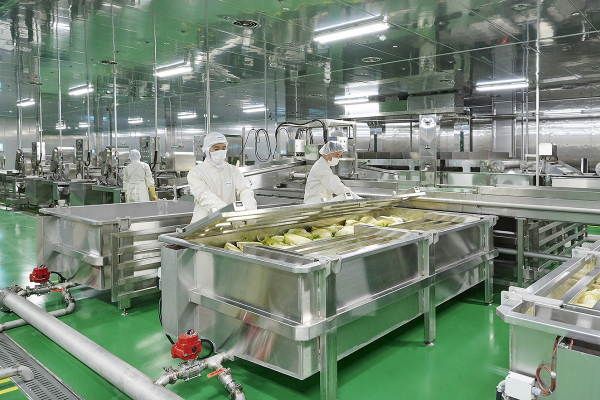

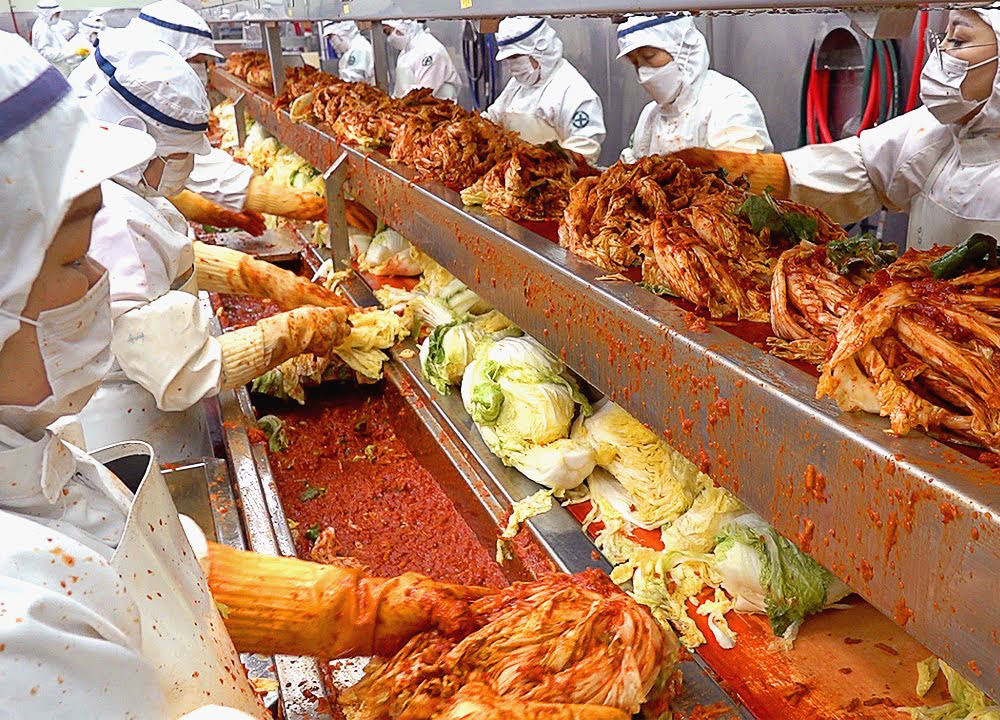

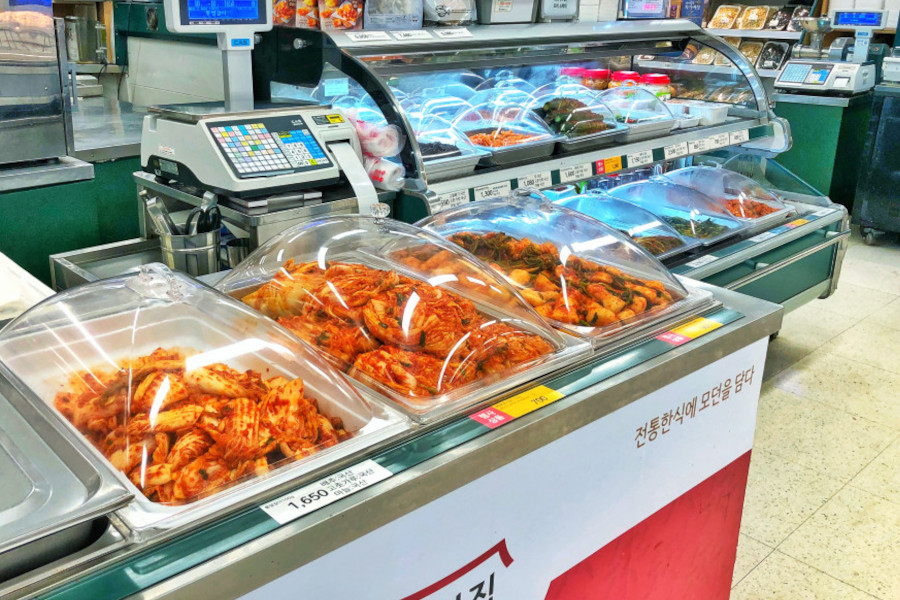
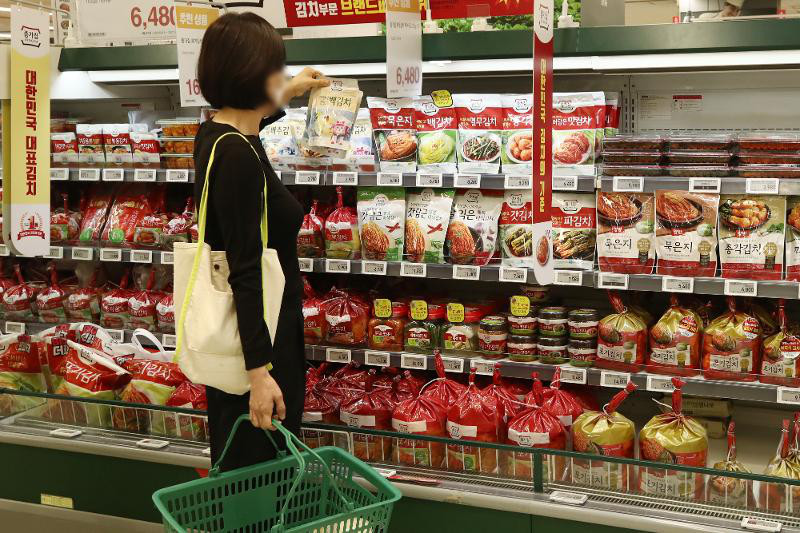

of home refrigerator

for longer storage

Kimchi Dishes
Kimchi is known to be a traditional side dish as it is almost always served along with other side dishes in most Korean family households and restaurants. Kimchi can be eaten alone or with white or brown rice, but it is also included in recipes of other traditional dishes, including porridges, soups, and rice cakes. Kimchi is also the basis for many derivative dishes such as Kimchi stew (김치찌개; Kimchijjigae), Kimchi pancake (김치전; Kimchibuchimgae), Kimchi soup (김칫국; Kimchiguk), and Kimchi fried rice (김치볶음밥; Kimchibokkeumbap).
Army base stew (부대찌개; Budae-jjigae) is a popular dish made with spam, sausage, and kimchi. It originated after the Korean war with ingredients that would be scrounged from the army.
Advantages
There are many fermented foods that are famous around the world, but Kimchi is a fermented food using vegetables. Since it is a collection of various vegetables including cabbage , the advantages of the vegetable itself can be cited. First of all, you can get most of the vitamin elements contained in vegetables with just one Kimchi. It is not a completely raw vegetable, but as it is salted and aged for a long time with seasoning, it is not a raw vegetable as it is, but it is an advantage that you can take care of a certain amount of balanced nutrition.
In fact, the biggest reason Kimchi is recognized is because of lactic acid bacteria. Since Metchnikov ‘s study on lactobacillus intake and life extension (1908 Nobel Prize in Physiology or Medicine), the efficacy of lactic acid bacteria (lactic acid bacteria) has been sufficiently verified, and there are many studies on Kimchi lactic acid bacteria. The effects of Kimchi are said to improve digestion, suppress germs that cause skin diseases, decompose cholesterol (this is more than coke with lactic acid bacteria and garlic in Kimchi), prevent adult diseases and lose weight, and greatly reduce the intake of irritating foods. When hypothesized, it is said that it is effective for stomach ulcers , but most of this is due to the abundance of lactic acid bacteria.
However, there are many lactic acid bacteria in other foods, but if you ask why Kimchi has been recognized for its effectiveness, it is because of ‘the viability of the unique lactic acid bacteria living in Kimchi’. Lactobacillus Kimchii (named after Kimchi, as you can see), a unique lactic acid bacteria that is not found in dairy products, lives there, and is much more viable than the lactic acid bacteria found in most dairy products. Although the survival rate of animal lactic acid bacteria is difficult to exceed 40%, vegetable lactic acid bacteria About 90% or more of gastric acidIt is possible to survive even in. Furthermore, if it is a germ that can survive in kimchi made with irritating spices and seasonings, its survival rate easily exceeds that of most products.
In other words, it means that there is a small gap between the content of lactic acid bacteria and the number of bacteria that can settle in the intestine. In other words, you need to consume a larger amount of other products to reach the required amount of lactic acid bacteria, but Kimchi is a kind of lactobacillus superfood, and if you properly control the amount, it can become a pretty good healthy food. It is possible to supplement to some extent by consuming foods containing lactic acid bacteria or related health products, but just knowing that you can quickly fill the required amount with a few pieces of Kimchi will tell you how effective lactic acid bacteria intake is. It does not mean that other products are inferior, but there is no doubt that it is one of the useful foods if it can reach the desired effect faster and more effectively.
Since lactic acid bacteria are at the center of the effectiveness of Kimchi, some health foods cultivate lactic acid bacteria in kimchi separately and combine them with dairy products. However, it is not yet known whether the efficacy is more efficient than taking lactic acid bacteria directly by eating Kimchi. As mentioned above, the efficacy of Kimchi does not come only from lactic acid bacteria, but numerous beneficial substances produced during the fermentation process also play a big role. Therefore, whether the desired effect can be obtained by separately culturing Kimchi lactobacillus (especially since it is obvious that it will be mixed with a huge amount of sugar and animal lactobacillus) requires more research.
According to Yeungnam University Professor Park Yong-ha’s research team, 2,000 pigs infected with animal coronavirus (PED-CoV) were fed Kimchi lactic acid bacteria, and they were 100% cured within a week. Professor Park explained that eating Kimchi lactic acid bacteria can increase immunoglobulin A, G ( IgA , IgG ), and gamma interferon to prevent viral infection.
Disadvantages
Apart from the effectiveness of lactic acid bacteria, the problem is the enormous sodium content as the liver is strong. It reaches 646mg per 100g , which is about 100mg more than Spam , which is rumored to be salty . However, in the media, Kimchi is often thought of as a food that symbolizes Koreans, such as having an unverified anti-cancer effect or as a sanctuary.
However, this is related to the eating habits of Koreans, and at one time it was a form of eating a lot of both rice and side dishes. However, in this case, the cost is high, so the side dishes are seasoned with strong ingredients to eat a lot of rice that is relatively cheaper than the side dishes. Salty and savory food (the taste of amino acids) such as salted fish, kimchi, and soy sauce made it easy to eat boring rice, which specialized in obtaining high calories at a low cost. This explains why an overly strong taste was treated as a lowly taste, and a boring and bland taste was treated as a nobleman or high-class food. Conversely, most of the foods that are considered common people’s foods tend to have a strong overall taste. It’s not just Kimchi, it’s because it’s the same with sauces. Even now, if you try the food of developing countries such as Southeast Asia that are economically unsatisfactory, it is quite simple.
This diet has not been a problem in the past. Yangban, who deserved to live, ate less salt and ate less salty food on their own, and ordinary farmers did hard farming, but it was because it was more difficult to live by eating salty food than not eating it at all. Even if you eat 100g of kimchi with each meal, it does not exceed the daily recommended sodium level.
The problem is modern society. In modern times, eating habits are formed in which the amount of main grains consumed, in short, the amount of rice gradually decreases and the amount of side dishes is increased. Based on this, the sodium content of traditional Korean food has become too high. Considering that one of the reasons our ancestors used salt was to kill bacteria other than lactic acid bacteria and long-term preservation in the days when there were no refrigerators, there is no need to add so much salt even today.
However, this does not mean that rice simply has the value of filling the stomach and gaining calories. Among carbohydrates , it is a complex carbohydrate, not a sugar, and it is a great source of nutrients because it contains several components. This is the same for soup, stew, and side dishes made in the traditional way.
However, you can reduce the amount of salt while making other side dishes, but pickles cannot be preserved if you reduce the amount of salt. In short, commercially available salted seafood that is tailored to the taste of modern people will go bad if not stored in the refrigerator. This is because salt is used overwhelmingly less than before. However, since fewer people make pickled fish, this point is less recognized and it has become natural for salted fish to have an expiration date attached to it . If the salinity is low right now, even if you pickle cabbage, you won’t die easily, and even after making kimchi, it will go bad quickly. In fact, there are many recommendations to use refined salt only for the salt used when making Limchi, because refined salt has a higher salinity than sun- dried salt , which is generally used.
The problem is that Koreans consume kimchi as a side dish for side dishes. There are not many Koreans who eat only ‘white rice with Kimchi’ calmly, and eat Kimchi with side dishes that are already sufficiently seasoned. For example , rice is rolled in soup dishes such as Ramen and Seolleongtang , and then topped with kimchi. Salt used in traditional kimchi is self -salt As a result, the mineral content is high and the salt content is about 10-20% lower than that of salt in other countries . can simply be judged that it will not occur. In reality, there are more complex factors, so they are not 100% the same. If you try it, it doesn’t seem that salty (compared to more salty dishes), but you just can’t feel it because the taste is disturbed by the sour and spicy taste.
Some scholars argue that the potassium contained in Chinese cabbage interferes with sodium absorption and is therefore less harmful than the total amount of sodium. There is so much potassium contained in cabbage that it cannot be covered. However, in fact, contrary to the stories that say ‘a handful of kimchi is 40 times the recommended daily amount’ or ‘the recommended daily amount even if you eat only two pieces’, the daily salt content of low-sodium kimchi is 270mg, which is close to 14% of the daily recommended amount. The average level of 740mg was 37%, and when calculated based on the overall average intake of kimchi, 500mg was 25%. A simple comparison is that, compared to sodium intake in North America, North Americans eat less cheese.
40% more sodium than Kimchi. Considering the effects of various refined sugars and food additives, which make people feel less full even if they consume the same amount of calories, the more such substances are added, the more serious they are in terms of excess calories and salt intake. In terms of absolute amount, it is clear that the salt content of kimchi is high, but compared to other high-salt foods, Kimchi is not that high-salt food. Even so, there is a sense that the salt content is higher than necessary, and although the effect of kimchi comes from complex factors, in fact, high salt content does not have a significant effect. Kimchi is widely used as a base for other foods, such as stir-frying Kimchi and rice as the main ingredients when other ingredients are not abundant, or boiling kimchi with only tuna or pork, and adding salt or soy sauce while cooking. In addition, even if the absolute amount of salt is the same, the concentration is not diluted because vegetables and the like do not enter enough, and the intake of potassium that helps salt discharge is reduced. To put it a bit exaggeratedly, it is a type of eating rice with Kimchi, soup with kimchi, and 2-3 kinds of Kimchi as a side dish.
The reason for the high salt content of kimchi is that it is attributed to the Korean food culture. In fact, there is a bit of a complicated debate about how much salt intake is appropriate. It goes without saying that too much extreme is not good, but ‘how much’ is the best has not been clarified. The recommendations of WHO and others inevitably set the standard, and even that continues to change.
Some claim extreme low salt content, while others insist on high salt health methods, and only the innocent people are confused among pseudo-medicines, commercial health functional food companies, the media, and various expert groups. In addition, the value of kimchi is that it is a fermented food, but the disadvantage is that you cannot fully utilize its advantages because lactic acid bacteria die when processed and cooked . Among traditional fermented foods, kimchi has a particularly high proportion of raw food, so the situation is good. However, there are studies that say that even dead lactic acid bacteria are better than none because some of the active ingredients remain even when heated .
History
- The origin of Kimchi dates back at least to the early period of the Three Kingdoms (37 BC‒7 AD). Fermented foods were widely available, as the Records of the Three Kingdoms, a Chinese historical text published in 289 AD, mentions that “The Goguryeo people [referring to the Korean people] are skilled in making fermented foods such as wine, soybean paste, and salted and fermented fish” in the section named Dongyi in the Book of Wei. Samguk Sagi, a historical record of the Three Kingdoms of Korea, also mentions the pickle jar used to ferment vegetables, which indicates that fermented vegetables were commonly eaten during this time. During the Silla dynasty (57 BC – AD 935), kimchi became prevalent as Buddhism caught on throughout the nation and fostered a vegetarian lifestyle.
- The pickling of vegetables was an ideal method, prior to refrigerators, that helped to preserve the lifespan of foods. In Korea, Kimchi was made during the winter by fermenting vegetables, and burying it in the ground in traditional brown ceramic pots called Onggi. This labor further allowed a bonding among women within the family. A poem on Korean radish written by Yi Gyubo, a 13th-century literatus, shows that radish kimchi was a commonplace in Goryeo (918–1392).
Pickled radish slices make a good summer side-dish,
Radish preserved in salt is a winter side-dish from start to end.
The roots in the earth grow plumper every day,
Harvesting after the frost, a slice cut by a knife tastes like a pear.
— Yi Gyubo, Donggukisanggukjip —
(translated by Michael J. Pettid, in Korean cuisine: An Illustrated History)
- Kimchi has been a staple in Korean culture, but historical versions were not a spicy dish. Early records of kimchi do not mention garlic or chili pepper. Chili peppers, now a standard ingredient in kimchi, had been unknown in Korea until the early seventeenth century due to its being a New World crop. Chili peppers, originally native to the Americas, were introduced to East Asia by Portuguese traders. The first mention of chili pepper is found in Jibong yuseol, an encyclopedia published in 1614. Sallim gyeongje, a 17‒18th century book on farm management, wrote on kimchi with chili peppers. However, it was not until the 19th century that the use of chili peppers in kimchi was widespread. The recipes from early 19th century closely resemble today’s kimchi.
- A 1766 book, Jeungbo Sallim Gyeongje, reports kimchi varieties made with myriad ingredients, including Chonggak-Kimchi (Kimchi made with Chonggak radish), Oi-sobagi (with cucumber), Seokbak-ji (with Jogi-jeot), and Dongchimi. However, Napa cabbage was introduced to Korea only at the end of 19th century, and whole-cabbage kimchi similar to its current form is described in Siuijeonseo, a cookbook published around that time.
- Kimchi is a national dish of both North and South Korea. During South Korea’s involvement in the Vietnam War its government requested American help to ensure that South Korean troops, reportedly “desperate” for the food, could obtain it in the field; South Korean president Park Chung-hee told U.S. President Lyndon B. Johnson that kimchi was “vitally important to the morale of Korean troops”. It was also sent to space on board Soyuz TMA-12 with South-Korean astronaut Yi So-yeon after a multimillion-dollar research effort to kill the bacteria and lessen the odor without affecting taste. On 22 November 2017 a Google Doodle was used to “Celebrate Kimchi”.
Recent Issues
- 1996 Japanese Kimchi dispute : South Korea developed programs for adult Korean adoptees to return to South Korea and learn about what it means to be Korean. One of these programs was learning how to make kimchi.
- 2010 Kimchi ingredient price crisis : Due to heavy rainfall shortening the harvesting time for cabbage and other main ingredients for Kimchi in 2010, the price of Kimchi ingredients and Kimchi itself rose greatly. Korean and international newspapers described the rise in prices as a national crisis. Some restaurants stopped offering kimchi as a free side dish, which The New York Times compared to an American hamburger restaurant no longer offering free ketchup. In response to the Kimchi price crisis, the South Korean government announced the temporary reduction of tariffs on imported cabbage to coincide with the Kimjang season.
- 2012 effective ban of Korean Kimchi exports to China : Since 2012, the Chinese government has effectively banned Korean Kimchi exports to China through government regulations. Ignoring the standards of Kimchi outlined by the Codex Alimentarius, China defined Kimchi as a derivative of one of its own cuisines, called Pao Cai. However, due to significantly different preparation techniques from Pao Cai, Kimchi has significantly more lactic acid bacteria through its fermentation process, which exceeds China’s regulations. Since 2012, commercial exports of Korean Kimchi to China has reached zero, the only minor amounts of exports accounting for Korean Kimchi are exhibition events held in China.
- Intangible Cultural Heritage of Humanity : Kimchi-related items have been inscribed on UNESCO’s Representative List of the Intangible Cultural Heritage of Humanity by both South and North Korea. This makes kimchi the second intangible heritage that was submitted by two countries, the other one being the folk song “Arirang” which was also submitted by both the Koreas.
- Submitted by South Korea (inscribed 2013) : Kimjang, the tradition of making and sharing of Kimchi that usually takes place in late autumn, was added to the list as “Kimjang, making and sharing kimchi in the Republic of Korea”. The practice of Kimjang reaffirms Korean identity and strengthens family cooperation. Kimjang is also an important reminder for many Koreans that human communities need to live in harmony with nature.
- Submitted by North Korea (inscribed 2015) : North Korean Kimchi-making was inscribed on the list in December 2015 as “Tradition of Kimchi-making in the Democratic People’s Republic of Korea”. North Korean Kimchi tends to be less spicy and red than South Korean Kimchi. Seafood is used less often and less salt is added. Additional sugar is used to help with fermentation in the cold climate.
- Boycott in China : A 2017 article in The New York Times said that anti-Korean sentiment in China has risen after South Korea’s acceptance of the deployment of THAAD in South Korea, government-run Chinese news media has encouraged the boycott of South Korean goods, and Chinese nationalists have vowed to not eat Kimchi. The move was criticized by other Chinese nationalists, who note that China officially consider Koreans an integral ethnic group in the multinational state, and that Kimchi is also indigenous to the Koreans in the Yanbian Korean Autonomous Prefecture.